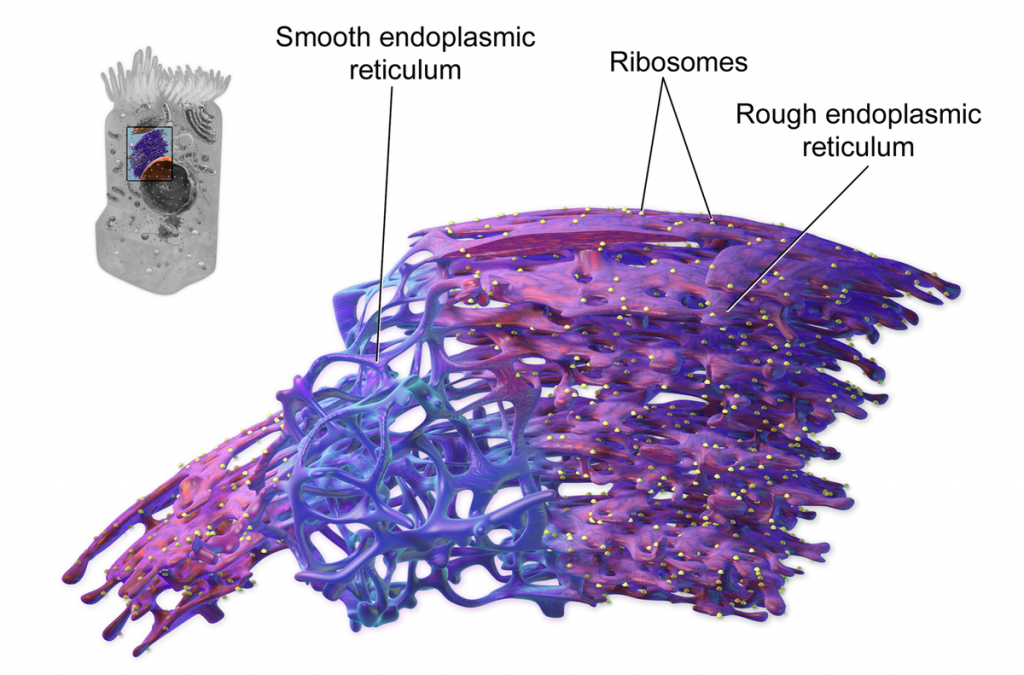Endoplasmic Reticulum (ER) is a continuous and complex system of interconnected flattened membranous sacs and tubules that runs through the cytoplasm. It divides the cytoplasm into two compartments- luminal (inside the ER) and extraluminal (rest of the cytoplasm). It provides mechanical support by serving as a skeletal framework and is responsible for producing various proteins and lipids.
Index
History
Garnier was the first to observe the ER under a Light Microscope in 1897. Porter, Claude, and Fullam were the first to study it under an Electron Microscope in 1953.
Types of Endoplasmic Reticulum
ER can be classified as Smooth (SER) and Rough Endoplasmic Reticulum (RER) depending upon the nature of its membranes:
- Smooth Endoplasmic Reticulum: Also called agranular ER as it lacks ribosomes. Also involved in lipid metabolism.

- Rough Endoplasmic Reticulum: Also called granular ER. There are two types of glycoproteins (Ribophorin I and Ribophorin II) that attach Ribosomes to ER.
Difference between Rough and Smooth ER
| Smooth ER | Rough ER |
| It is devoid of ribosomes and, thus, is also called agranular ER | It has ribosomes attached to its surface and, thus, is also called granular ER |
| It mainly consists of vesicles and tubules | It primarily consists of cisternae and a few tubules |
| It is involved in the synthesis of glycogen lipids and steroids. | It takes part in the synthesis of proteins and enzymes |
| It is devoid of Ribophorins | Ribophorins are present |
| It is involved in the formation of sphaerosomes | It gives rise to lysosomes along with the Golgi complex |
Structure
ER can consist of three structures-
- Cisternae structures: These are flattened membranous sac-like. They lie parallel to each other.
- Vesicles: These are oval or rounded sacs that appear as small vacuoles.
- Tubules: These are tubular structures that may be interconnected to cisternae and vesicles to form a network.
Functions
- Common functions of RER and SER:
- They provide a large surface for physiological activities and mechanical support by serving as a skeletal framework.
- In plants, ER (as desmotubules) regulates the movement of substances between neighbouring cells through plasmodesmata.
- It serves as a means for quick transportation and provides precursor material to the Golgi complex for processing.
- Functions of SER:
- SER involves in the formation of sphaerosomes. SER is responsible for synthesizing lipids and glycogen.
- It regulates the release of Ca^{2+} in muscle cells as sarcoplasmic reticulum.
- Detoxification with the aid of cytochrome P-450
- Functions of RER:
- RER performs glycosylation.
- It synthesizes a number of proteins and enzymes on account of the presence of ribosomes.
- RER forms SER by discarding ribosomes.
Related topics:
Questions
- What is the Endoplasmic Reticulum?
ER is a continuous and complex system of interconnected flattened membranous sacs and tubules that runs through the cytoplasm. It provides mechanical support by serving as a skeletal framework and is responsible for producing various proteins and lipids.
- What are the two types of Endoplasmic Reticulum?
It can be classified as Smooth (SER) and Rough Endoplasmic Reticulum (RER), depending upon the presence of ribosomes on its membranes.
FAQs
The smooth Endoplasmic Reticulum is involved in forming sphaerosomes and synthesises lipids and glycogen.
It performs glycosylation, i.e., it is involved in modifying and transforming polypeptides synthesized by ribosomes. It synthesizes a number of proteins and enzymes on account of the presence of ribosomes.
ER divides the cytoplasm into two compartments- luminal (inside the ER) and extraluminal (rest of the cytoplasm).
Endoplasmic Reticulum can occur as Cisternae, Vesicles, and Tubules. It is a continuous and complex system of interconnected flattened membranous sacs and tubules that runs through the cytoplasm.
It starts from the nuclear membrane of the cell and runs through the cytoplasm.
